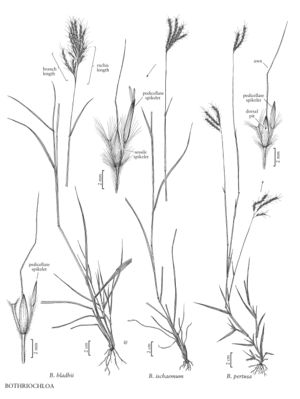Difference between revisions of "Bothriochloa pertusa"
imported>Volume Importer |
imported>Volume Importer |
||
| Line 47: | Line 47: | ||
|publication year= | |publication year= | ||
|special status=Introduced | |special status=Introduced | ||
| − | |source xml=https://bitbucket.org/aafc-mbb/fna-data-curation/src/ | + | |source xml=https://bitbucket.org/aafc-mbb/fna-data-curation/src/200273ad09963decb8fc72550212de541d86569d/coarse_grained_fna_xml/V25/V25_1564.xml |
|subfamily=Poaceae subfam. Panicoideae | |subfamily=Poaceae subfam. Panicoideae | ||
|tribe=Poaceae tribe Andropogoneae | |tribe=Poaceae tribe Andropogoneae | ||
Latest revision as of 17:57, 11 May 2021
Plants cespitose or stoloniferous. Culms to 100 cm, often decumbent or stoloniferous, freely branching; nodes bearded. Leaves mostly basal, green, sometimes glaucous; sheaths glabrous, keeled; ligules 0.7-1.5 mm; blades 3-15 cm long, 3-4 mm wide, flat, margins and ligule regions hairy. Panicles 3-5 cm, fan-shaped, often purplish; rachises 0.2-2 cm, with 3-8 branches; branches 3-4.5 cm, longer than the rachises, usually with 1 rame; rame internodes with villous margins, with 1-3 mm hairs. Sessile spikelets 3-4 mm, lanceolate; callus hairs about 1 mm; lower glumes sparsely hirtellous, with a prominent dorsal pit near the middle; awns 10-17 mm; anthers 1-1.8 mm, yellow. Pedicellate spikelets the same size as the sessile spikelets, sterile, pitted or not, occasionally with 2 pits. 2n = 40, 60.
Distribution
Puerto Rico, Md., Tex., La., Virgin Islands, Pacific Islands (Hawaii), Miss., Fla.
Discussion
Bothriochloa pertusa is native to the Eastern Hemisphere, and was introduced to the southern United States as a warm-season pasture grass. It now grows in disturbed, moist, grassy places and pastures in the region, at elevations of 2-200 m. It has not persisted at all locations shown on the map.
Selected References
None.
